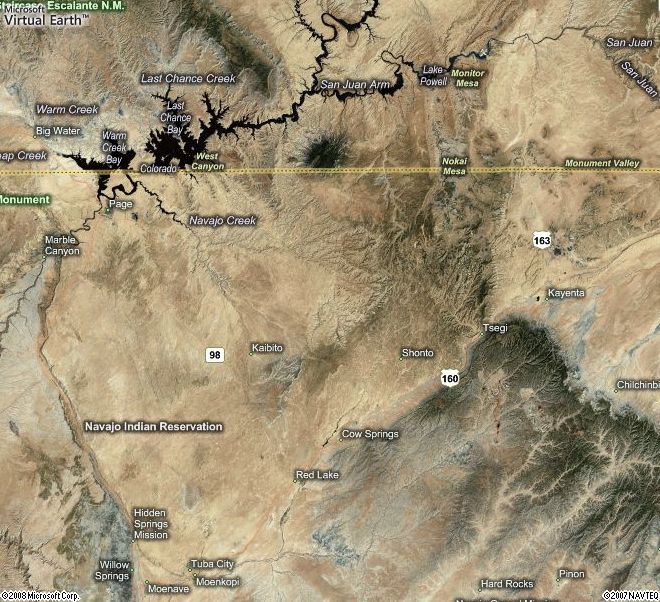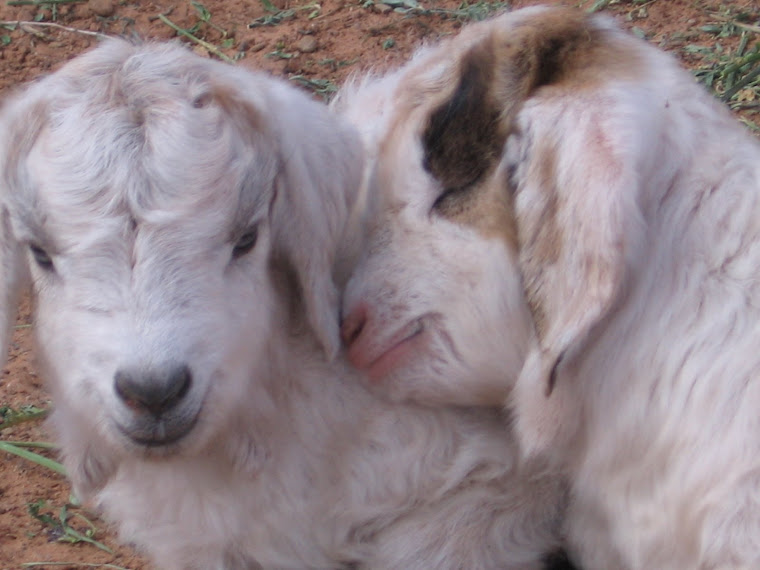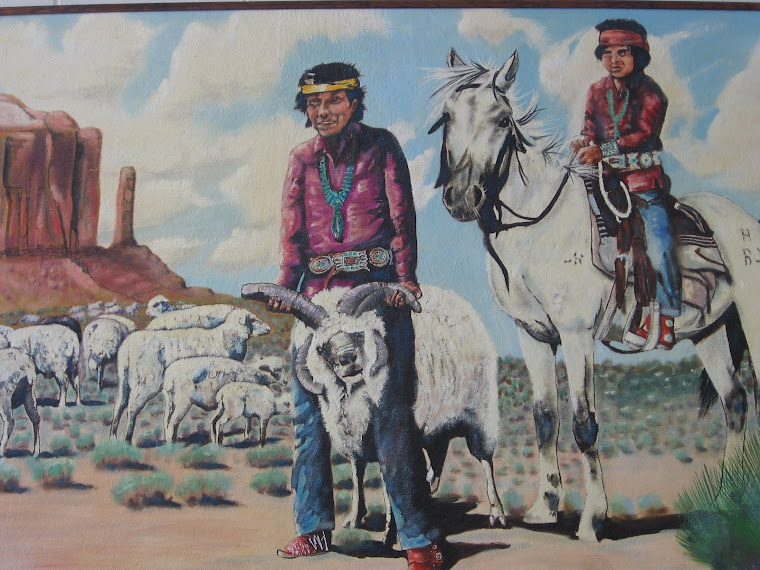As a child I listened to my father stand before his community and tribal leaders expressing his visions about the Colorado River. He shared the importance of acquiring usage of the Colorado River by the Navajo Tribe. He also spoke of environmental issues, stating the selling of sacred source of coal and water would deminish the "Navajo way" and the price for them would be destrimental to the People.
Today I am witnessing the urgency to find water source in most of the Navajo reservation land. My family-land-use is split by the former Bennett Freeze Act---BIA fence running right through the land. This is now one of the factors in the longated hardship for the People of the Western Navajo reservation. The access to clean water and watering holes for the animals are numberless. The People go beyond their community to buy barreled water for their households, for their livestocks----just to live another drought driven season.
Many People know the Peabody Coal Mines (located 10 miles away from my family's land) has been a major source of environmental degradation to the Navajo land. For over 30 years, with our Tribal Government's permission, they have slurred the coal to Nevada with our fresh water. The sole water source that is much needed has gone away from the People to another part of the country. The company continues to slur coal but from another region of the State of Arizona. The environment impact of digging for coal, acquiring coal, transporting coal, using coal and disposing coal all adds up to the price of water and air.
Solutions are a few, give the inherited water rights back to the People of the community and we as Navajo citizens must be willing to accept it and protect it. Our Tribal Government has not done well in protecting the People's interest, they seem to not be able to restrain from instant gratification (imagine the unreported information we will not know of, chilling).
Some solutions....
Drill for more wells and wind mills.
Channel the run off water appropriately and fix the animal watering holes.
Send a voice to the Navajo tribal government, to Congress....to your family and friends.
30.4.08
Mount Taylor (update)
Cibola County opposes Mount Taylor cultural listing
By HEATHER CLARK Associated Press Writer
Article Launched: 04/30/2008 04:16:32 PM MDT
ALBUQUERQUE, N.M.—The Cibola County Commission has come out against an emergency listing of Mount Taylor in the State Register of Cultural Properties, a designation requested by five American Indian communities that consider the mountain sacred.
Commissioners voted 4-1 Tuesday to oppose the listing in what was described by attendees as a "very heated" and sometimes racially charged meeting attended by hundreds of people. The Cultural Properties Review Committee had approved the designation for Mount Taylor in February.
The commission's resolution, obtained by The Associated Press, states that commissioners are concerned that Mount Taylor's listing may restrict the rights of private landowners whose ownership dates back to the 1700s. It also said the county has benefited from multiple uses of the land, which include farming, ranching, logging, mining and other activities.
Katherine Slick, director of the State Historic Preservation Office, said the designation does not affect private property and landowners' ability to make improvements or sell their property.
County Manager David Ulibarri, who is also a state senator, said the commission decided to look into the issue because county residents felt they did not have a voice in the decision to place Mount Taylor on the state register.
The resolution called on the state attorney general's office to determine whether the Cultural Properties Review Committee violated the state Open Meetings Act by not properly giving notice of the February meeting at which Mount Taylor was temporarily listed on the register.
Slick said she's not aware that the office violated the Open Meetings Act.
"We followed the normal process, which is that we send notice of the meeting to the press boxes at the Capitol building, and that happened," she said.
A spokesman for the attorney general's office said the matter is under review.
The emergency designation will protect Mount Taylor for a year while the Cultural Properties Review Committee investigates whether the area should be permanently listed.
Mount Taylor, near Grants, rises to 11,301 feet and can be seen from many parts of the state. The protected 422,840-acre area includes the summit and mesa tops above 8,000 feet, except on the southwest boundary where the protected area drops to 7,300 feet.
Commissioner Jane Pitts, who supported the resolution, said private landowners are being given different answers about what the designation means.
Pitts said her position is "not anti-Native American. I want to preserve their sacred sites and I want them to have a say, but I want to have a say, too, and that's all this is about. I believe in freedom and this squashed ours."
The designation would make it more difficult for companies hoping to explore for uranium in the area to get necessary state exploration permits.
Ulibarri said Cibola County already has passed a resolution supporting uranium mining's return to the area. The industry could bring in billions of dollars to the state.
"We have that resource. That is economic development for this area," he said.
But Anna Rondon, a community-based land use planning consultant and an anti-uranium activist, said she and others hope the designation for Mount Taylor will end renewed interest in uranium mining in the area. The price of uranium has increased from $7 per pound in 2003 to a current level of $65 per pound, renewing interest in such mining in New Mexico.
Rondon, who attended Tuesday's meeting, described it as "very heated" with racial tension between tribal members and other residents.
"I was there because the mountain's sacred to me and I'm Navajo," Rondon said. "This is all about stopping uranium."
Acoma Pueblo led the effort to place the mountain on the state register. Zuni and Laguna pueblos, the Navajo Nation and the Hopi Tribe in Arizona joined Acoma. The tribes have said the mountain has spiritual significance and is considered life sustaining. They ascribe human qualities and personalities to the mountain by conducting prayers and pilgrimages.
Keith Tenorio, Acoma tribal secretary, said the pueblo was not ready Wednesday to make a statement about the commission's opposition to the designation.
The tribes have one year to persuade the committee to place the mountain on the Register of Cultural Properties permanently. If they fail, the mountain will become ineligible to be listed for five years.
Slick, who attended the commission meeting, said speakers showed their concern for Mount Taylor.
"Almost to a person, those who spoke showed that the community at large values Mount Taylor as a community cultural site," she said.
By HEATHER CLARK Associated Press Writer
Article Launched: 04/30/2008 04:16:32 PM MDT
ALBUQUERQUE, N.M.—The Cibola County Commission has come out against an emergency listing of Mount Taylor in the State Register of Cultural Properties, a designation requested by five American Indian communities that consider the mountain sacred.
Commissioners voted 4-1 Tuesday to oppose the listing in what was described by attendees as a "very heated" and sometimes racially charged meeting attended by hundreds of people. The Cultural Properties Review Committee had approved the designation for Mount Taylor in February.
The commission's resolution, obtained by The Associated Press, states that commissioners are concerned that Mount Taylor's listing may restrict the rights of private landowners whose ownership dates back to the 1700s. It also said the county has benefited from multiple uses of the land, which include farming, ranching, logging, mining and other activities.
Katherine Slick, director of the State Historic Preservation Office, said the designation does not affect private property and landowners' ability to make improvements or sell their property.
County Manager David Ulibarri, who is also a state senator, said the commission decided to look into the issue because county residents felt they did not have a voice in the decision to place Mount Taylor on the state register.
The resolution called on the state attorney general's office to determine whether the Cultural Properties Review Committee violated the state Open Meetings Act by not properly giving notice of the February meeting at which Mount Taylor was temporarily listed on the register.
Slick said she's not aware that the office violated the Open Meetings Act.
"We followed the normal process, which is that we send notice of the meeting to the press boxes at the Capitol building, and that happened," she said.
A spokesman for the attorney general's office said the matter is under review.
The emergency designation will protect Mount Taylor for a year while the Cultural Properties Review Committee investigates whether the area should be permanently listed.
Mount Taylor, near Grants, rises to 11,301 feet and can be seen from many parts of the state. The protected 422,840-acre area includes the summit and mesa tops above 8,000 feet, except on the southwest boundary where the protected area drops to 7,300 feet.
Commissioner Jane Pitts, who supported the resolution, said private landowners are being given different answers about what the designation means.
Pitts said her position is "not anti-Native American. I want to preserve their sacred sites and I want them to have a say, but I want to have a say, too, and that's all this is about. I believe in freedom and this squashed ours."
The designation would make it more difficult for companies hoping to explore for uranium in the area to get necessary state exploration permits.
Ulibarri said Cibola County already has passed a resolution supporting uranium mining's return to the area. The industry could bring in billions of dollars to the state.
"We have that resource. That is economic development for this area," he said.
But Anna Rondon, a community-based land use planning consultant and an anti-uranium activist, said she and others hope the designation for Mount Taylor will end renewed interest in uranium mining in the area. The price of uranium has increased from $7 per pound in 2003 to a current level of $65 per pound, renewing interest in such mining in New Mexico.
Rondon, who attended Tuesday's meeting, described it as "very heated" with racial tension between tribal members and other residents.
"I was there because the mountain's sacred to me and I'm Navajo," Rondon said. "This is all about stopping uranium."
Acoma Pueblo led the effort to place the mountain on the state register. Zuni and Laguna pueblos, the Navajo Nation and the Hopi Tribe in Arizona joined Acoma. The tribes have said the mountain has spiritual significance and is considered life sustaining. They ascribe human qualities and personalities to the mountain by conducting prayers and pilgrimages.
Keith Tenorio, Acoma tribal secretary, said the pueblo was not ready Wednesday to make a statement about the commission's opposition to the designation.
The tribes have one year to persuade the committee to place the mountain on the Register of Cultural Properties permanently. If they fail, the mountain will become ineligible to be listed for five years.
Slick, who attended the commission meeting, said speakers showed their concern for Mount Taylor.
"Almost to a person, those who spoke showed that the community at large values Mount Taylor as a community cultural site," she said.
29.4.08
Dried Corn Stew

Dried Corn Stew
Recipe by Elaya K Tsosie
--------------------------------------------------------------------------------
3 cups water
1 cup dried corn (can substitute 1 cup dry garbanzo beans)
1 pound beef stew meat
1 cup chopped onion
1 teaspoon salt
1/8 teaspoon pepper
In saucepan, combine water and corn (or garbanzo beans); bring to boiling. Reduce heat and simmer, uncovered, for 2 minutes. Remove from heat. Cover; let stand several hours. Return to boiling; simmer, covered, 1/2 more than an hour if using corn or 1 hour if using garbanzo beans for this recipe. Add remaining ingredients. Simmer, covered, until tender, about 1 1/2 hours. Season to taste. Makes 4 servings.
Navajo president pushes reduction of tribal lawmakers
Navajo president pushes reduction of tribal lawmakers
By FELICIA FONSECA Associated Press Writer
Article Launched: 04/29/2008 05:06:42 PM MDT
WINDOW ROCK, Ariz.—Navajo President Joe Shirley Jr. is moving forward with a plan to reform the tribal government and first on his wish list is reducing the Tribal Council from 88 delegates to 24. Shirley's staff filed paperwork Tuesday with the tribe's election office that will start the process in gathering signatures to put the question before voters. The petitioners will have six months to collect about 16,000 signatures, but Shirley said the goal is to get at least 25,000 in 90 days so that the matter could go before voters in the November elections.
"The sentiment of the people, I feel, is that they want to reform government," he said in a recent interview. "I don't think a lot of them like the way our government is run."
J.R. Thompson of the Navajo Nation Election Administration said his office received the documents late Tuesday. The names of petitioners need to be checked against voter registration rolls before signatures can be gathered, and Thompson said that could take a couple of days.
"Until we see that everything is proper and in order, then they can proceed with it," he said.
Shirley announced the formation of a government reform task force last week during the council's spring session. He also wants voters to approve a line item veto that would give him the authority to approve or reject certain budget items or supplemental appropriations.
Former Arizona state Rep. Sylvia Laughter, acting executive director of the Office of Navajo Government Development, said while she supports a move to reduce the council, she sees Shirley's push for a line item veto as a power play.
"The line item veto tells me that he's not willing to work with the legislative body," she said. "At the same time, the legislative body is just as much at fault. ... There just seems to be a lot of difficulty in moving forward with anything."
The executive and legislative branches have been at odds recently over a proposed $36 million legislative complex, discretionary funds and the draining of a capital improvement fund.
While Shirley has exercised his veto power on a number of bills he said included unnecessary appropriations, the council hasn't hesitated to override those vetoes.
One of Shirley's biggest challenges in reducing the council likely will come from the delegates.
More than half of the 88 tribal lawmakers represent two or more communities, and downsizing the council would cheat communities out of representation in the tribal capital of Window Rock, said council Speaker Lawrence Morgan.
"The Navajo people should be worried about the president's move," he said.
Navajos voted in a 2000 referendum to reduce the council to 24 delegates, but the measure failed because its language required a majority vote in each of the tribe's 110 chapters.
Delegate Leonard Tsosie said he believes Navajo voters would be receptive to reducing the council and having delegates work harder to get elected.
"It will be harder, more competition, but in a way I don't mind," he said. "I think the Navajo people should be afforded the competition of ideas on how to make better their own lives, their community and the Navajo Nation."
If a reduction is approved, only 24 delegates would be elected in 2010. The Navajo Board of Election Supervisors would reapportion the delegates with approval of the current council by August 15, 2009. If the council rejects the plan, the Navajo president would have the authority to develop and approve a plan.
The line item veto would go into effect immediately if approved.
Delegate Leslie Dele said Shirley should have a plan before the issues are voted on.
The council created a reform office shortly after the tribal government was reorganized in 1989 under three branches—the executive, legislative and judicial—though Navajo voters never ratified the change. Previously, a chairman served as both the head of the tribal government and the speaker of the council.
The council voted late last year to place the office under the administrative control of Morgan. Shirley vetoed the measure, but the council overturned it.
Laughter's main focus has been looking at the feasibility of establishing a Navajo constitution. The Navajo Nation is one of a few tribes that rejected a constitution under the Indian Reorganization Act of 1934.
Shirley suggested that a constitution could be part of government reform, but said "It's not my initiative."
Dale Mason, a political science professor at the University of New Mexico's Gallup branch, said there is widespread support for reducing the council—partly to save money—but doesn't believe Shirley has the clout to pull it off.
"I think there are a lot of Navajos that would like the Navajo government changed, but I don't think there's a consensus on what it should be," he said.
By FELICIA FONSECA Associated Press Writer
Article Launched: 04/29/2008 05:06:42 PM MDT
WINDOW ROCK, Ariz.—Navajo President Joe Shirley Jr. is moving forward with a plan to reform the tribal government and first on his wish list is reducing the Tribal Council from 88 delegates to 24. Shirley's staff filed paperwork Tuesday with the tribe's election office that will start the process in gathering signatures to put the question before voters. The petitioners will have six months to collect about 16,000 signatures, but Shirley said the goal is to get at least 25,000 in 90 days so that the matter could go before voters in the November elections.
"The sentiment of the people, I feel, is that they want to reform government," he said in a recent interview. "I don't think a lot of them like the way our government is run."
J.R. Thompson of the Navajo Nation Election Administration said his office received the documents late Tuesday. The names of petitioners need to be checked against voter registration rolls before signatures can be gathered, and Thompson said that could take a couple of days.
"Until we see that everything is proper and in order, then they can proceed with it," he said.
Shirley announced the formation of a government reform task force last week during the council's spring session. He also wants voters to approve a line item veto that would give him the authority to approve or reject certain budget items or supplemental appropriations.
Former Arizona state Rep. Sylvia Laughter, acting executive director of the Office of Navajo Government Development, said while she supports a move to reduce the council, she sees Shirley's push for a line item veto as a power play.
"The line item veto tells me that he's not willing to work with the legislative body," she said. "At the same time, the legislative body is just as much at fault. ... There just seems to be a lot of difficulty in moving forward with anything."
The executive and legislative branches have been at odds recently over a proposed $36 million legislative complex, discretionary funds and the draining of a capital improvement fund.
While Shirley has exercised his veto power on a number of bills he said included unnecessary appropriations, the council hasn't hesitated to override those vetoes.
One of Shirley's biggest challenges in reducing the council likely will come from the delegates.
More than half of the 88 tribal lawmakers represent two or more communities, and downsizing the council would cheat communities out of representation in the tribal capital of Window Rock, said council Speaker Lawrence Morgan.
"The Navajo people should be worried about the president's move," he said.
Navajos voted in a 2000 referendum to reduce the council to 24 delegates, but the measure failed because its language required a majority vote in each of the tribe's 110 chapters.
Delegate Leonard Tsosie said he believes Navajo voters would be receptive to reducing the council and having delegates work harder to get elected.
"It will be harder, more competition, but in a way I don't mind," he said. "I think the Navajo people should be afforded the competition of ideas on how to make better their own lives, their community and the Navajo Nation."
If a reduction is approved, only 24 delegates would be elected in 2010. The Navajo Board of Election Supervisors would reapportion the delegates with approval of the current council by August 15, 2009. If the council rejects the plan, the Navajo president would have the authority to develop and approve a plan.
The line item veto would go into effect immediately if approved.
Delegate Leslie Dele said Shirley should have a plan before the issues are voted on.
The council created a reform office shortly after the tribal government was reorganized in 1989 under three branches—the executive, legislative and judicial—though Navajo voters never ratified the change. Previously, a chairman served as both the head of the tribal government and the speaker of the council.
The council voted late last year to place the office under the administrative control of Morgan. Shirley vetoed the measure, but the council overturned it.
Laughter's main focus has been looking at the feasibility of establishing a Navajo constitution. The Navajo Nation is one of a few tribes that rejected a constitution under the Indian Reorganization Act of 1934.
Shirley suggested that a constitution could be part of government reform, but said "It's not my initiative."
Dale Mason, a political science professor at the University of New Mexico's Gallup branch, said there is widespread support for reducing the council—partly to save money—but doesn't believe Shirley has the clout to pull it off.
"I think there are a lot of Navajos that would like the Navajo government changed, but I don't think there's a consensus on what it should be," he said.
Subscribe to:
Posts (Atom)















